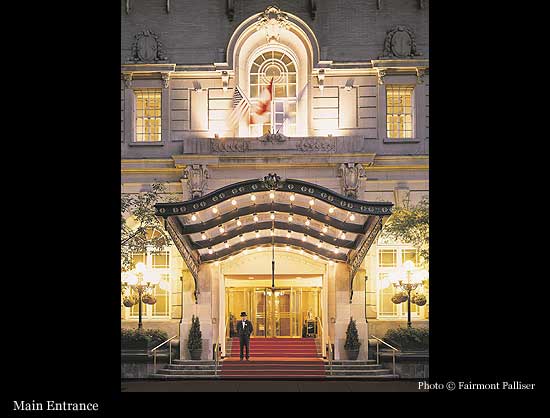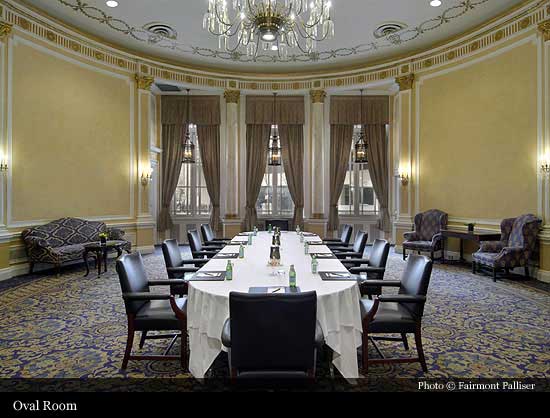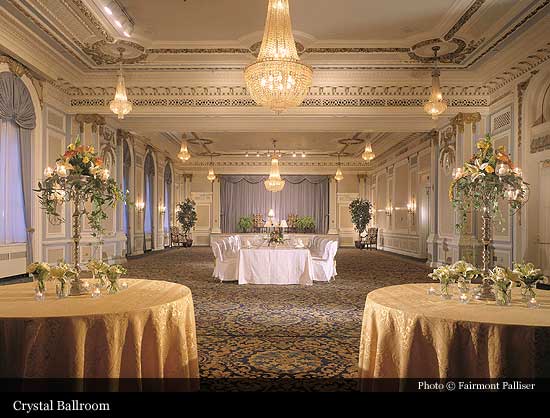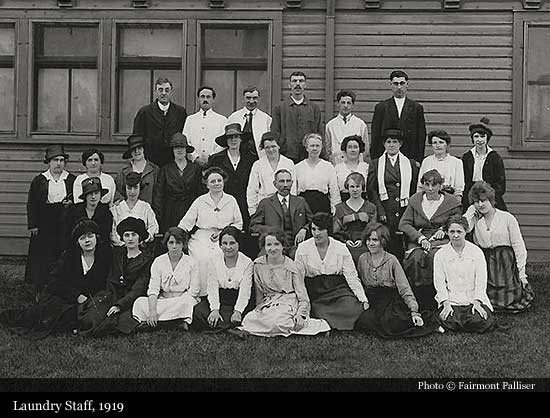< CANADA | CALGARY: Fairmont Palliser
1914
Fairmont Palliser
Calgary
133 9th Avenue SW
Calgary (AB), T2P 2M3
Canada
Phone: +1 403 262 1234
Fax: +1 403 260 1260
www.fairmont.com/palliser-calgary
Facebook | Twitter | Instagram
GPS: 51° 02' 39.6" N 114° 03' 53.8" W
MAKE A RESERVATION
powered by: Booking.com
When the Canadian Pacific Railway pushed west in 1883, Calgary was essentially a mounted police post and trading center. With an influx of tourists, mainly en route to Canadian Pacific's Banff Springs hotel (now The Fairmont Banff Springs), a hospitality spot in Calgary was an essential link. As William Van Horne, General Manager of Canadian Pacific Railway, declared, "If we can't export the scenery, we'll import the tourists." This led to the building of one of the finest hotels in Calgary, Alberta.
 The Fairmont Palliser luxury hotel opened as The Palliser on June 1, 1914. The public areas were fitted with oak paneling, candelabras, marble columns and floors, handmade rugs and public art. Ice water,
along with hot and cold running water, was available in the 350 guest rooms, which featured mahogany doors, brass beds and windows. Named after Captain John Palliser, who explored the area in the 1850s,
the eight-floor building was enlarged in 1929, with another $30 million in renovations and restoration recently made.
The Fairmont Palliser luxury hotel opened as The Palliser on June 1, 1914. The public areas were fitted with oak paneling, candelabras, marble columns and floors, handmade rugs and public art. Ice water,
along with hot and cold running water, was available in the 350 guest rooms, which featured mahogany doors, brass beds and windows. Named after Captain John Palliser, who explored the area in the 1850s,
the eight-floor building was enlarged in 1929, with another $30 million in renovations and restoration recently made.
The Palliser hotel in Calgary was built in the Edwardian Commercial style. Architect Lawrence Gotch adopted a Chicago look, with straight geometric lines resembling the innumerable prairie grain elevators
found in Alberta and other prairie provinces. The E-shape of the service floors was designed to provide all rooms with outside lighting and created the appearance of three adjacent towers.
The Lobby, originally known as the Rotunda, is considered Renaissance Revival, with gray Tennessee marble floors and columns finished in Botticino and Sylvian marble, a ticket office, telegraph and telephone
bureau, flower stand and elevator hall.
On June 2, 1993, the Crown granted the luxury hotel a Heraldic Badge - a first time event for any hotel. This ended The Palliser's rather dubious practice of "borrowing" Captain John Palliser's family crest.
With wild roses representing the Provincial flower of Alberta and wavy lines representing the Bow and Elbow River junction where Calgary is situated, the badge followed the original Palliser family crest as
much as possible.
The Tudor-style Rimrock Restaurant, named by Banff artist Charles Beil, whose 38-ft mural depicting a rimrock was installed in 1962, features a heraldic sign above the fireplace with images such as a locomotive
and a sickle. R. B. Bennett, Prime Minister of Canada from 1930 to 1935, lived in the hotel for stretches of time between 1922 and 1938, and had a regular table beside the fireplace. In the 1960s, architect
Earl Morrison wanted to remove the fireplace for kitchen access, but adamant Calgarians persuaded the hotel to save the "landmark."
Renamed the Palliser Room in 1954, The Louis XIV-style Crystal Ballroom held dances for decades, but because of strict liquor rules, the hotel did not serve alcohol and people resorted to hip flasks or bottles
hidden under formal gowns. Long tablecloths hid the forbidden substance during supper and waiters served ginger ale and turned a blind eye while guests mixed their own drinks.
The Canadian Pacific Railway Pavilion, built to preserve and showcase Canadian Pacific's history, is a partnership between the hotel and the railway company. The magnificent glass rotunda was inspired by late
19th century railway station design and complements the hotel's architectural detail and provides a home for Canadian Pacific's vintage train cars. Catered by the hotel's restaurant, the Pavilion and heritage
cars can be rented for private functions and events.
Additional literature: n/a


































